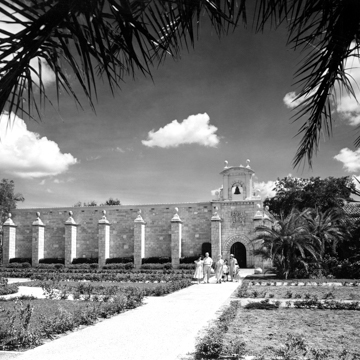The oldest extant building in Florida exemplifies the state’s complex relationship with history and heritage. The Ancient Spanish Monastery is at once nine centuries old and just six decades old, simultaneously alien and local, both a tourist folly and a sacred space. Its story embodies the vicissitudes of a region whose architectural heritage is anything but straightforward.
Originally built as the Cistercian Monastery of Our Lady, Queen of the Angels, in Sacramenia, a province of Segovia in northern Spain, the complex was constructed between 1133 and 1141. It was dedicated to Saint Mary and its humble massing and ornamental details reflected the ideals of humility and purity practiced by the Cistercian order. The relative lack of decoration and statuary lend the architecture a sense of simplicity and austerity, and emphasize its elegant proportions and craftsmanship. The monastery combines Romanesque and Gothic motifs, with semicircular arches standing alongside pointed ones. The compound in North Miami Beach includes the cloisters, chapter house, and refectory of the original monastery, whose church and other structures remained in Iberia (where they were declared a national monument in 1931).
The Monastery was renamed in honor of Bernard of Clairvaux, when the Cistercian monk was canonized in 1174. For the next six centuries, a monastic community lived on site and maintained the monastery until it was expropriated in 1835 during the ecclesiastical confiscations of Mendizábel—a set of decrees that allowed the nobles to confiscate and privatize monastic properties—and repurposed as a granary and stable. In 1925, newspaper magnate William Randolph Hearst purchased the cloister and outbuildings with the goal of reassembling them at San Simeon; the building, however, never made it to California.
Hearst had the structure dismantled for shipment to the United States. Each stone was numbered and carefully packed in a wooden crate that was cushioned internally with hay. Approximately 11,000 crates were shipped to New York. Yet when they arrived, customs officials alarmed by an outbreak of hoof and mouth disease in Segovia ordered the hay burned to prevent transmitting the disease to America livestock. In the process, the numbering system was lost (making reconstruction much more difficult) and the onset of the Great Depression several years later forced Hearst to abandon the project. The disassembled monastery remained in a warehouse in Brooklyn until after his death in 1951.
The following year, entrepreneurs Raymond Moss and William Edgemon purchased the pieces of the monastery with the intention of creating a new tourist attraction in South Florida. The stones were shipped to Miami and the complex was reassembled on a six-acre site on West Dixie Highway. This painstaking archaeological process took nineteen months and cost $1.5 million (over $20 million in 2015) to complete. Moss and Edgemon renamed the structure the Ancient Spanish Monastery.
Bishop Henry Louttit purchased the monastery in 1964 for the Episcopal Diocese of South Florida. The structure was reconsecrated as the Episcopal Church of St. Bernard de Clairvaux. However, financial difficulties forced the diocese (by then split into three dioceses) to sell the complex to Colonel Robert Pentland Jr., who then donated it to the newly formed Episcopal Diocese of Southeast Florida. The Ancient Spanish Monastery is home to the Parish of St. Bernard de Clairvaux, and remains a popular tourist attraction.
Because of its unique architecture and well-kept gardens, the Ancient Spanish Monastery also serves as a popular site for commercial photography. It has been used as a location in several films, including a stint as a mental hospital in the 1994 comedy, Ace Ventura: Pet Detective. The Ancient Spanish Monastery was added to the National Register of Historic Places in 1972.
References
Evans, G. R. Bernard of Clairvaux. New York: Oxford University Press, 2000.
Moncy, Nick. “The Ancient Spanish Monastery Is A North Miami Beach Gem That You Have To Visit.” Rise: Miami News, August 21, 2015.





